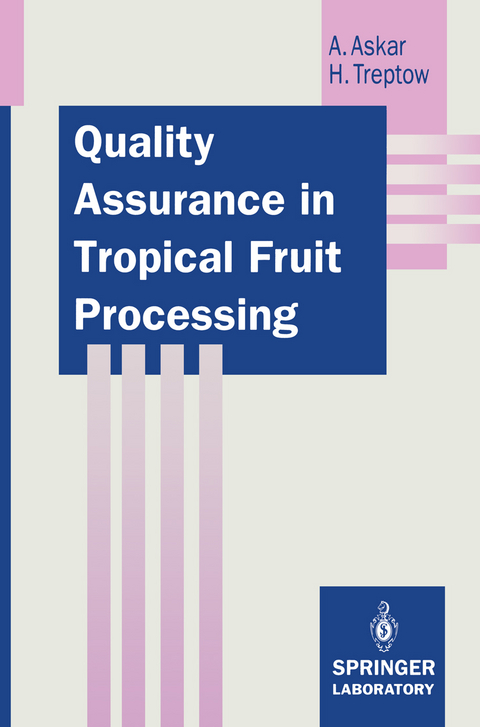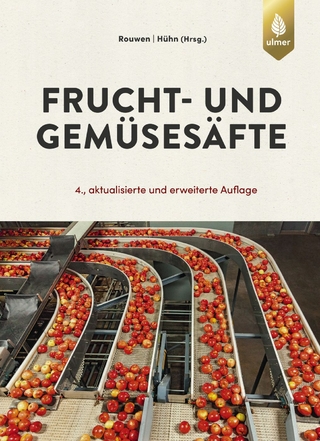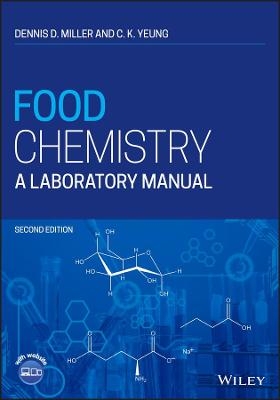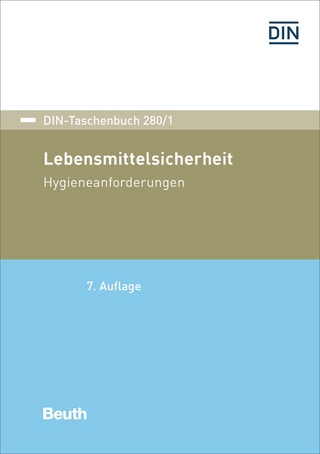
Quality Assurance in Tropical Fruit Processing
Springer Berlin (Verlag)
978-3-642-77689-2 (ISBN)
Growth of microorganisms and chemical reactions are often detrimental to both raw materials and products in the processing of fruits in tropical or subtropical climates. This book presents classical and modern methods of analysis and quality control in the processing of tropical fruits. Special attention is given to economic and rapid methods which are especially suitable in tropical climates and which, in most cases, can be carried out easily.
1 Quality Assurance Management.- 2 Analytical Methods.- 2.1 Determination of Moisture.- 2.2 Total Soluble Solids (Brix).- 2.3 Determination of Sugars.- 2.3.1 Determination of Reducing Sugars.- 2.3.2 Determination of Total Sugars.- 2.3.3 Chromatographic Analysis of Sugars.- 2.3.4 Enzymatic Analysis of Sugars.- 2.4 Starch Test.- 2.5 Determination of Alcohol Insoluble Solids.- 2.6 Determination of Acidity.- 2.6.1 Determination of Titratable Acidity.- 2.6.2. Determination of Organic Acids.- 2.6.2.1 Gas-Liquid Chromatography (GLC).- 2.6.2.2 High Performance Liquid Chromatography (FIPLC).- 2.6.2.3 Enzymatic Determination.- 2.7 The Brix/Acid-Ratio.- 2.8 Measurement of pH.- 2.9 Determination of Ash.- 2.10 Determination of Vitamin C.- 2.11 Determination of Carotenoids.- 2.12 Determination of Anthocyanins.- 2.13 Determination of Benzoic Acid.- 2.14 Determination of Sorbic Acid.- 2.15 Determination of Sulphur Dioxide.- 2.16 Determination of Pectinesterase Activity.- 2.17 Measurement of Cloud Stability.- 2.18 Colour Index.- 2.19 Determination of Non-enzymatic Browning.- 2.20 Determination of Furfural.- 2.21 Determination of Hydroxymethylfurfural.- 3 Physical Measurements.- 3.1 Measurement of Colour.- 3.2 Measurement of Consistency.- 3.2.1 Viscosity.- 3.3 Distance Consistometer.- 3.3.1 Texture.- 3.4 Puncture Testing.- 3.5 Distance Measuring Instruments.- 3.6 Measurement of Water Activity.- 4 Sensory Analysis.- 4.1 Organization of the Tests.- 4.2 Statistical Test Designs.- 4.2.1 Difference Tests.- 4.2.2 Quantitative Difference Tests.- 4.2.3 Descriptive Flavour Profile.- 4.2.4 Threshold Test.- 4.3 Selection and Training of Panel Members.- 4.4 Statistical Tables.- 5 Microbiological Analysis.- 5.1 Facilities, Equipment, Glassware, and Media for a Modest Microbiological Laboratory.- 5.2 Microbiological Examination of Tropical Fruit Products.- 5.2.1 Direct Microscopic Count (DMC).- 5.2.1.1 Film Method.- 5.2.1.2 Counting Chamber.- 5.2.2 Colony Count Methods.- 5.2.2.1 General Guidelines.- 5.2.2.2 Culture Media.- 5.2.3 Fermentation Test.- 5.3 Classification of Microorganisms.- 5.4 Detection of Microbial Contamination and Spoilage Using Chemical Methods.- 5.4.1 Determination of Diacetyl.- 5.4.1.1 Distillation Method.- 5.4.1.2 GLC Method.- 5.4.2 Determination of Lactic Acid.- 5.4.2.1 A Rapid Spot Test for the Detection of Lactic Acid.- 5.4.2.2 Enzymatic Determination of Lactic Acid.- 6 Water Control.- 6.1 Importance and Standards.- 6.2 Methods of Analysis.- 6.2.1 Measurement of Colour.- 6.2.2 Measurement of Turbidity.- 6.2.3 Measurement of pH.- 6.2.4 Measurement of Conductivity.- 6.2.5 Determination of Residue, Filterable and Non-filterable Residue.- 6.2.6 Determination of Alkalinity.- 6.2.7 Determination of Hardness.- 6.2.8 Determination of Iron.- 6.2.9 Determination of Nitrate.- 6.2.10 Determination of Residual Chlorine.- 6.2.11 Determination of Toxic Metals.- 6.3 Microbiological Examination.- 6.3.1 Total Count.- 6.3.2 Coliform Tests.- 6.3.2.1 Presumptive Test.- 6.3.2.2 Confirmed Test.- 6.3.2.3 Completed Test.- 6.3.3 Coliform Test by Membrane Filter Technique.- 7 Sanitation Control.- 7.1 Definition and Terminology.- 7.2 Factors Affecting Cleaning Efficiency and Costs.- 7.2.1 Nature of Soil and Soil Formation.- 7.2.2 Water Quality.- 7.2.3 Temperature.- 7.2.4 Turbulence.- 7.2.5 Time.- 7.2.6 Nature of Surfaces and Surface Finishes.- 7.2.7 Detergent Formulation and Concentration.- 7.2.8 Disinfectants (Sanitizers).- 7.2.9 Chlorination of Water.- 7.2.10 Cleaning Procedures.- 7.3 Evaluation of Cleanliness and Sanitation.- 7.3.1 Visual Evaluation.- 7.3.2 Microbiological Evaluation.- 7.4 Control of Employee Hygienic Practices.- 7.5 Pest Control.- 8 Waste Disposal Control.- 8.1 Definition and Terminology.- 8.2 Factors to be Considered in Waste Disposal Control.- 8.2.1 Character of the Waste.- 8.2.2 Waste Flow.- 8.2.3 Segregation of Highly Contaminated Wastewater.- 8.2.4 Reduction of Waste Flow.- 8.2.5 Solid Waste Disposal and Utilization.- 8.2.6 Existing
| Erscheint lt. Verlag | 16.12.2011 |
|---|---|
| Reihe/Serie | Springer Lab Manuals |
| Zusatzinfo | XII, 238 p. |
| Verlagsort | Berlin |
| Sprache | englisch |
| Maße | 155 x 235 mm |
| Gewicht | 393 g |
| Themenwelt | Technik ► Lebensmitteltechnologie |
| Schlagworte | food industry • Food Processing • Food Processing Quality Control • Food Technology • Getränketechnologie • Microorganism • plants • Processing • Qualitätskontrolle • Quality assurance |
| ISBN-10 | 3-642-77689-2 / 3642776892 |
| ISBN-13 | 978-3-642-77689-2 / 9783642776892 |
| Zustand | Neuware |
| Haben Sie eine Frage zum Produkt? |
aus dem Bereich


